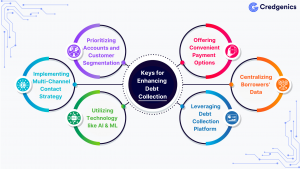With rising consumer debt levels, increasing pressure on profitability and heightened competition, banks and other non-banking finance companies need to innovate when it comes to debt collection processes. Traditional models often fall short, leading to inefficiencies and strained customer relationships. Challenges such as manual processes, disconnected communication channels, and data management issues significantly hinder collections teams. Lack of automation in contacting debtors and tracking payments is prone to errors and delays, while fragmented communication leads to inefficiency and miscommunication. Additionally, working with inaccurate or incomplete data hampers effective targeting of accounts for collection efforts.
By leveraging advanced technology platforms and adopting a strategic approach, lenders can transform their debt recovery landscape. This blog explores six powerful ways to improve debt collections processes effectively to ensure higher recovery rates, improve customer satisfaction, and streamline operations. By integrating these strategies, lending organizations can stay ahead of the curve and foster a more resilient and responsive debt collection framework.
Strategies for Enhancing Debt Collections
The debt collection industry in India is witnessing a digital transformation, with a surging demand for technology-driven solutions. As businesses strive to optimize their debt recovery processes, embracing innovative strategies is paramount. The Indian digital consumer lending sector is expected to reach $720 billion by 2030, highlighting the immense potential and need for efficient debt collection practices. The following six approaches are effective in transforming the debt collection process for financial entities:

#1 Prioritizing Accounts and Customer Segmentation
Debts vary a lot based on their type, tenure, risk and repayment flow. Segment borrowers based on factors like outstanding amount, payment history, and risk profile. High-risk accounts can be managed more aggressively, while low-risk accounts can be handled leniently to maintain customer relationships. For example, businesses may dedicate more efforts to following up on larger, older debts, while implementing an automated call system for smaller, more recent delinquencies.
Recommended Read: Understanding Loan Delinquency
Recommended Read: Understanding Loan Delinquency
#2 Providing Convenient Payment Options
Make it easy for borrowers to repay their debts. Offering multiple, convenient payment methods increases the chances of debt repayment. Options such as online payments and card payments cater to diverse customer preferences and make it easier for borrowers to settle their debts. For instance, lending companies could leverage a digital payment platform to give borrowers the option to pay via mobile using a custom payment link.
#3 Implementing Multi-Channel Contact Strategy
Don’t rely on a single method of communication. Use a variety of channels to reach out to borrowers, such as automated phone calls, WhatsApp, Voicebots, IVR, emails, and SMS. This will increase the chance of getting in touch with borrowers and resolving the delinquency. For example, lenders could identify the preferred channel, time, frequency, mode, language for communication and adopt a personalized model.
#4 Centralizing Borrowers Data
Ensure that all borrower information is stored in a central location and that it is up-to-date. This will make it easier for financial institutions to track and manage debt collection activities. Moreover, access to comprehensive data helps in making informed decisions and ensures consistency in communication.
For instance, they could leverage a centralized debt collection system to store all borrower interactions, payment histories, contact details, and other important data. This will ensure that their collection team has up-to-date information.
#5 Utilizing Technology
Implement advanced technologies such as artificial intelligence (AI) and machine learning (ML) coupled with data analytics to enhance debt collection efforts. These technologies can help in predicting delinquency risk, optimizing collection strategies, and automating various routine tasks. For instance, AI and ML-powered systems can analyze borrower data to identify patterns and prioritize high-risk accounts.
#6 Leveraging Debt Collections Platform
Consider using an advanced debt collections platform to automate multiple tasks associated with debt collection. These platforms offer tools for automating reminders, tracking payments, and generating reports. This can streamline the entire collection process and improve debt collection efficiency. For example, lenders can use a debt collections platform to automate follow-up emails and texts, simplify payments, and generate performance reports for management review.
How Credgenics Can Help
Credgenics empowers financial institutions with innovative solutions to streamline and personalize the debt collections process, saving valuable time for their teams. By leveraging advanced digital capabilities and AI / ML technologies, Credgenics enables automated and personalized reminders for borrowers when the repayments become overdue. The platform also offers convenient payment methods, such as instant tailored payment links that are embedded in communications across channels, allowing borrowers to settle their dues promptly.
Credgenics serves as an integrated platform for debt management, providing custom dashboards, complete visibility on performance and data backed insights on the strategy. Through unified dashboards and insightful analytics, lenders can effectively monitor the status of collections, make informed projections, and maintain a comprehensive overview of their debt collection efforts. With Credgenics, financial institutions can optimize their collections strategy, enhance borrower experiences, and drive sustainable growth.
FAQs:
Q1: What are the common challenges faced by collections teams?
Lack of Automation: Collections tasks like contacting debtors, sending out reminders, and managing payments are often slow and error-prone due to a lack of automation.
Disconnected Communication: Collections teams often deal with disconnected communication channels, which can lead to inefficiency and delays.
Data Management: Many organizations struggle with inaccurate or incomplete data, making it difficult to track down debtors and collect on debts.
Q2: What are the key strategies to boost debt collection efforts?
Prioritize accounts based on risk profiles, offer convenient payment options like online / mobile, and implement multi-channel contact strategies. Furthermore, centralize borrower data for accessibility, and leverage AI/ML for risk prediction and personalized strategies. Most importantly, use a trusted debt collection platform for streamlined and efficient debt recovery processes.
Q3: How can a debt collections platform benefit financial institutions?
By streamlining various tasks such as sending reminders, payment collection, and report generation. In other words, these platforms can automate many time-consuming aspects of debt collection for financial institutions. This can lead to improved efficiency and better overall performance in debt collection.
Q4: How does technology play an important role in enhancing debt collection efforts?
Technologies like AI and ML, along with data analytics, can be helpful tools for debt effective collection. These technologies help predict delinquency risk, optimize collection strategies, and automate routine tasks. Moreover, the technologies help collectors reach debtors efficiently and personalize collection strategies.






